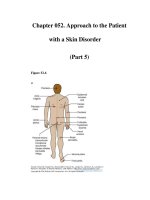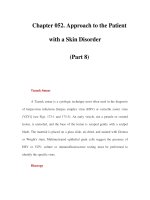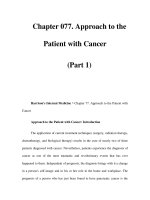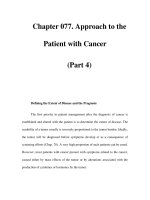Chapter 077. Approach to the Patient with Cancer (Part 3) pptx
Bạn đang xem bản rút gọn của tài liệu. Xem và tải ngay bản đầy đủ của tài liệu tại đây (33.29 KB, 5 trang )
Chapter 077. Approach to the
Patient with Cancer
(Part 3)
Cancer Around the World
In 2002, 11 million new cancer cases and 7 million cancer deaths were
estimated worldwide. When broken down by region of the world, ~45% of cases
were in Asia, 26% in Europe, 14.5% in North America, 7.1% in Central/South
America, 6% in Africa, and 1% in Australia/New Zealand (Fig. 77-3). Lung
cancer is the most common cancer and the most common cause of cancer death in
the world. Its incidence is highly variable, affecting only 2 per 100,000 African
women but as many as 61 per 100,000 North American men. Breast cancer is the
second most common cancer worldwide; however, it ranks fifth as a cause of
death behind lung, stomach, liver, and colorectal cancer. Among the eight most
common forms of cancer, lung (2-fold), breast (3-fold), prostate (2.5-fold), and
colorectal (3-fold) cancers are more common in more developed countries than in
less developed countries. By contrast, liver (2-fold), cervical (2-fold), and
esophageal (2- to 3-fold) cancers are more common in less developed countries.
Stomach cancer incidence is similar in more and less developed countries but is
much more common in Asia than North America or Africa. The most common
cancers in Africa are cervical, breast, and liver cancers. It has been estimated that
nine modifiable risk factors are responsible for more than one-third of cancers
worldwide. These include smoking, alcohol consumption, obesity, physical
inactivity, low fruit and vegetable consumption, unsafe sex, air pollution, indoor
smoke from household fuels, and contaminated injections.
Figure 77-3
Patient Management
Important information is obtained from every portion of the routine history
and physical examination. The duration of symptoms may reveal the chronicity of
disease. The past medical history may alert the physician to the presence of
underlying diseases that may affect the choice of therapy or the side effects of
treatment. The social history may reveal occupational exposure to carcinogens or
habits, such as smoking or alcohol consumption, that may influence the course of
disease and its treatment. The family history may suggest an underlying familial
cancer predisposition and point out the need to begin surveillance or other
preventive therapy for unaffected siblings of the patient. The review of systems
may suggest early symptoms of metastatic disease or a paraneoplastic syndrome.
Diagnosis
The diagnosis of cancer relies most heavily on invasive tissue biopsy and
should never be made without obtaining tissue; no noninvasive diagnostic test is
sufficient to define a disease process as cancer. Although in rare clinical settings
(e.g., thyroid nodules) fine-needle aspiration is an acceptable diagnostic
procedure, the diagnosis generally depends on obtaining adequate tissue to permit
careful evaluation of the histology of the tumor, its grade, and its invasiveness and
to yield further molecular diagnostic information, such as the expression of cell-
surface markers or intracellular proteins that typify a particular cancer, or the
presence of a molecular marker, such as the t(8;14) translocation of Burkitt's
lymphoma. Increasing evidence links the expression of certain genes with the
prognosis and response to therapy (Chaps. 79, 80).
Occasionally a patient will present with a metastatic disease process that is
defined as cancer on biopsy but has no apparent primary site of disease. Efforts
should be made to define the primary site based on age, sex, sites of involvement,
histology and tumor markers, and personal and family history. Particular attention
should be focused on ruling out the most treatable causes (Chap. 95).
Once the diagnosis of cancer is made, the management of the patient is best
undertaken as a multidisciplinary collaboration among the primary care physician,
medical oncologists, surgical oncologists, radiation oncologists, oncology nurse
specialists, pharmacists, social workers, rehabilitation medicine specialists, and a
number of other consulting professionals working closely with each other and with
the patient and family.









